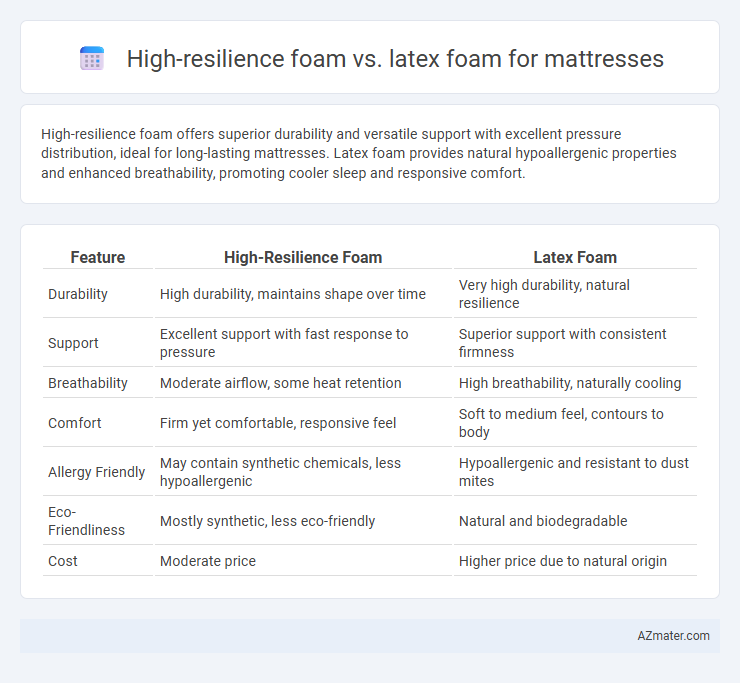High-resilience foam offers superior durability and versatile support with excellent pressure distribution, ideal for long-lasting mattresses. Latex foam provides natural hypoallergenic properties and enhanced breathability, promoting cooler sleep and responsive comfort.
Table of Comparison
| Feature | High-Resilience Foam | Latex Foam |
|---|---|---|
| Durability | High durability, maintains shape over time | Very high durability, natural resilience |
| Support | Excellent support with fast response to pressure | Superior support with consistent firmness |
| Breathability | Moderate airflow, some heat retention | High breathability, naturally cooling |
| Comfort | Firm yet comfortable, responsive feel | Soft to medium feel, contours to body |
| Allergy Friendly | May contain synthetic chemicals, less hypoallergenic | Hypoallergenic and resistant to dust mites |
| Eco-Friendliness | Mostly synthetic, less eco-friendly | Natural and biodegradable |
| Cost | Moderate price | Higher price due to natural origin |
Introduction to Mattress Foam Types
High-resilience foam offers enhanced durability and support due to its open-cell structure, making it ideal for pressure relief and maintaining mattress shape over time. Latex foam, derived from natural or synthetic sources, provides excellent responsiveness, breathability, and hypoallergenic properties, promoting comfort and airflow. Both foam types serve distinct purposes in mattress construction, catering to various sleep preferences and requirements.
What is High-Resilience (HR) Foam?
High-Resilience (HR) foam is a type of polyurethane foam known for its superior durability, elasticity, and support compared to traditional foam types, making it highly suitable for mattress construction. It offers excellent bounce and breathability, enhancing comfort by maintaining consistent pressure distribution and reducing heat retention. HR foam typically has a density between 1.8 to 2.8 pounds per cubic foot, which contributes to its resilience and long-lasting performance in mattresses.
What is Latex Foam?
Latex foam is a natural or synthetic material derived from rubber tree sap or petrochemicals, known for its elasticity, durability, and breathability. It offers excellent pressure relief and conforms to the body's shape while maintaining responsiveness and support. Compared to high-resilience foam, latex foam provides a cooler sleep surface and longer lifespan due to its inherent antimicrobial and hypoallergenic properties.
Key Differences: High-Resilience Foam vs Latex Foam
High-resilience foam offers superior durability and bounce due to its open-cell structure and higher ILD rating, making it ideal for pressure relief and edge support in mattresses. Latex foam, derived from natural or synthetic latex, provides enhanced responsiveness and hypoallergenic properties, with distinct natural ventilation that promotes breathability and moisture resistance. Key differences include resilience levels, material origin, and temperature regulation, influencing firmness, comfort, and mattress longevity.
Comfort and Support Comparison
High-resilience foam offers exceptional durability and responsive support, providing balanced comfort that adapts to body shape and weight for pressure relief. Latex foam delivers natural elasticity and breathability, enhancing comfort with a cooler sleep surface and consistent support that reduces motion transfer. Both materials excel in support, yet latex foam often outperforms in temperature regulation while high-resilience foam provides a slightly firmer feel ideal for spinal alignment.
Durability and Longevity: HR Foam vs Latex
High-resilience foam offers exceptional durability due to its dense cell structure, providing long-lasting support and resistance to sagging. Latex foam, especially natural latex, boasts superior longevity with its inherent elasticity and resistance to wear, often outlasting synthetic foams by several years. Both materials excel in durability, but latex foam typically delivers extended lifespan and consistent comfort over time compared to high-resilience foam.
Breathability and Temperature Regulation
High-resilience foam offers excellent breathability due to its open-cell structure, promoting superior airflow and effective moisture dissipation that helps maintain an even sleeping temperature. Latex foam, particularly natural latex, excels in temperature regulation by combining breathable, pinhole-perforated designs with antimicrobial properties, reducing heat buildup and enhancing comfort. Both materials provide distinct advantages in mattress cooling, but latex often outperforms high-resilience foam in sustaining a cooler sleep environment through its inherent elasticity and ventilation.
Allergy Considerations: Hypoallergenic Benefits
High-resilience foam offers excellent dust mite resistance and minimal allergen accumulation, making it a hypoallergenic choice ideal for sensitive sleepers. Latex foam, especially natural latex, is inherently resistant to mold, dust mites, and bacteria due to its antimicrobial properties. Both materials provide allergy-friendly benefits, but latex foam's natural hypoallergenic qualities often outperform synthetic high-resilience foam in preventing allergic reactions.
Cost and Value Analysis
High-resilience foam offers a cost-effective solution with excellent durability and support, making it ideal for budget-conscious buyers seeking long-term value. Latex foam, while more expensive, provides superior natural breathability, hypoallergenic properties, and enhanced pressure relief, justifying its higher price for those prioritizing comfort and health benefits. Overall, high-resilience foam maximizes affordability and performance, whereas latex foam excels in premium comfort and eco-friendly attributes, catering to different consumer needs and budgets.
Which Mattress Foam is Right for You?
High-resilience foam offers durable support with excellent bounce and responsiveness, making it ideal for those who prefer a firmer, more supportive mattress that adapts quickly to movement. Latex foam delivers a natural, breathable, and hypoallergenic sleeping surface with superior pressure relief and durability, favored by sleepers seeking eco-friendly materials and a slightly softer, contouring feel. Choosing between high-resilience and latex foam depends on your preference for bounce and support versus natural materials and contouring comfort.

Infographic: High-resilience foam vs Latex foam for Mattress
 azmater.com
azmater.com